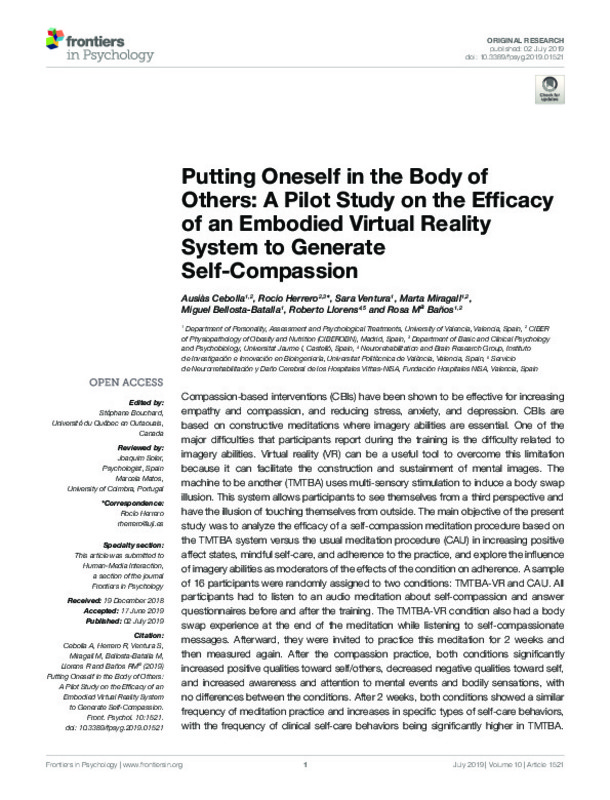Bertrand, P., Guegan, J., Robieux, L., McCall, C. A., & Zenasni, F. (2018). Learning Empathy Through Virtual Reality: Multiple Strategies for Training Empathy-Related Abilities Using Body Ownership Illusions in Embodied Virtual Reality. Frontiers in Robotics and AI, 5. doi:10.3389/frobt.2018.00026
Brito-Pons, G., Campos, D., & Cebolla, A. (2018). Implicit or Explicit Compassion? Effects of Compassion Cultivation Training and Comparison with Mindfulness-based Stress Reduction. Mindfulness, 9(5), 1494-1508. doi:10.1007/s12671-018-0898-z
Campos, A., & Pérez-Fabello, M. J. (2005). The Spanish Version of Betts’ Questionnaire upon Mental Imagery. Psychological Reports, 96(1), 51-56. doi:10.2466/pr0.96.1.51-56
[+]
Bertrand, P., Guegan, J., Robieux, L., McCall, C. A., & Zenasni, F. (2018). Learning Empathy Through Virtual Reality: Multiple Strategies for Training Empathy-Related Abilities Using Body Ownership Illusions in Embodied Virtual Reality. Frontiers in Robotics and AI, 5. doi:10.3389/frobt.2018.00026
Brito-Pons, G., Campos, D., & Cebolla, A. (2018). Implicit or Explicit Compassion? Effects of Compassion Cultivation Training and Comparison with Mindfulness-based Stress Reduction. Mindfulness, 9(5), 1494-1508. doi:10.1007/s12671-018-0898-z
Campos, A., & Pérez-Fabello, M. J. (2005). The Spanish Version of Betts’ Questionnaire upon Mental Imagery. Psychological Reports, 96(1), 51-56. doi:10.2466/pr0.96.1.51-56
Cebolla, A., Campos, D., Galiana, L., Oliver, A., Tomás, J. M., Feliu-Soler, A., … Baños, R. M. (2017). Exploring relations among mindfulness facets and various meditation practices: Do they work in different ways? Consciousness and Cognition, 49, 172-180. doi:10.1016/j.concog.2017.01.012
Cebolla, A., Galiana, L., Campos, D., Oliver, A., Soler, J., Demarzo, M., … García-Campayo, J. (2017). How Does Mindfulness Work? Exploring a Theoretical Model Using Samples of Meditators and Non-meditators. Mindfulness, 9(3), 860-870. doi:10.1007/s12671-017-0826-7
Chirico, A., Ferrise, F., Cordella, L., & Gaggioli, A. (2018). Designing Awe in Virtual Reality: An Experimental Study. Frontiers in Psychology, 8. doi:10.3389/fpsyg.2017.02351
Mindful Self-Care Scale (MSCS): Adaptation and Validation in a Normative Turkish Sample. (2018). European Journal of Educational Research, 7(4). doi:10.12973/eu-jer.7.4.887
Dahl, C. J., Lutz, A., & Davidson, R. J. (2015). Reconstructing and deconstructing the self: cognitive mechanisms in meditation practice. Trends in Cognitive Sciences, 19(9), 515-523. doi:10.1016/j.tics.2015.07.001
Day, S., Holmes, E., & Hackmann, A. (2004). Occurrence of imagery and its link with early memories in agoraphobia. Memory, 12(4), 416-427. doi:10.1080/09658210444000034
Ehrsson, H. H. (2007). The Experimental Induction of Out-of-Body Experiences. Science, 317(5841), 1048-1048. doi:10.1126/science.1142175
Falconer, C. J., Slater, M., Rovira, A., King, J. A., Gilbert, P., Antley, A., & Brewin, C. R. (2014). Embodying Compassion: A Virtual Reality Paradigm for Overcoming Excessive Self-Criticism. PLoS ONE, 9(11), e111933. doi:10.1371/journal.pone.0111933
Feliu-Soler, A., Pascual, J. C., Elices, M., Martín-Blanco, A., Carmona, C., Cebolla, A., … Soler, J. (2016). Fostering Self-Compassion and Loving-Kindness in Patients With Borderline Personality Disorder: A Randomized Pilot Study. Clinical Psychology & Psychotherapy, 24(1), 278-286. doi:10.1002/cpp.2000
Gilbert, P., & Irons, C. (2004). A pilot exploration of the use of compassionate images in a group of self‐critical people. Memory, 12(4), 507-516. doi:10.1080/09658210444000115
Goetz, J. L., Keltner, D., & Simon-Thomas, E. (2010). Compassion: An evolutionary analysis and empirical review. Psychological Bulletin, 136(3), 351-374. doi:10.1037/a0018807
Gonzalez-Hernandez, E., Romero, R., Campos, D., Burychka, D., Diego-Pedro, R., Baños, R., … Cebolla, A. (2018). Cognitively-Based Compassion Training (CBCT®) in Breast Cancer Survivors: A Randomized Clinical Trial Study. Integrative Cancer Therapies, 17(3), 684-696. doi:10.1177/1534735418772095
Hackmann, A., Bennett-Levy, J., & Holmes, E. A. (Eds.). (2011). Oxford Guide to Imagery in Cognitive Therapy. doi:10.1093/med:psych/9780199234028.001.0001
Kirby, J. N., Tellegen, C. L., & Steindl, S. R. (2017). A Meta-Analysis of Compassion-Based Interventions: Current State of Knowledge and Future Directions. Behavior Therapy, 48(6), 778-792. doi:10.1016/j.beth.2017.06.003
Kosslyn, S. M. (1994). Image And Brain. doi:10.7551/mitpress/3653.001.0001
Kraus, S., & Sears, S. (2008). Measuring the Immeasurables: Development and Initial Validation of the Self-Other Four Immeasurables (SOFI) Scale Based on Buddhist Teachings on Loving Kindness, Compassion, Joy, and Equanimity. Social Indicators Research, 92(1), 169-181. doi:10.1007/s11205-008-9300-1
Kroenke, K., Spitzer, R. L., & Williams, J. B. W. (2001). The PHQ-9. Journal of General Internal Medicine, 16(9), 606-613. doi:10.1046/j.1525-1497.2001.016009606.x
Longo, M. R., Schüür, F., Kammers, M. P. M., Tsakiris, M., & Haggard, P. (2008). What is embodiment? A psychometric approach. Cognition, 107(3), 978-998. doi:10.1016/j.cognition.2007.12.004
Löwe, B., Decker, O., Müller, S., Brähler, E., Schellberg, D., Herzog, W., & Herzberg, P. Y. (2008). Validation and Standardization of the Generalized Anxiety Disorder Screener (GAD-7) in the General Population. Medical Care, 46(3), 266-274. doi:10.1097/mlr.0b013e318160d093
Neff, K. D., & Dahm, K. A. (2015). Self-Compassion: What It Is, What It Does, and How It Relates to Mindfulness. Handbook of Mindfulness and Self-Regulation, 121-137. doi:10.1007/978-1-4939-2263-5_10
De Oliveira, E. C., Bertrand, P., Roel Lesur, M. E., Palomo, P., Demarzo, M., Cebolla, A., … Tori, R. (2016). Virtual Body Swap: A New Feasible Tool to Be Explored in Health and Education. 2016 XVIII Symposium on Virtual and Augmented Reality (SVR). doi:10.1109/svr.2016.23
Pearson, D. G., Deeprose, C., Wallace-Hadrill, S. M. A., Heyes, S. B., & Holmes, E. A. (2013). Assessing mental imagery in clinical psychology: A review of imagery measures and a guiding framework. Clinical Psychology Review, 33(1), 1-23. doi:10.1016/j.cpr.2012.09.001
Peck, T. C., Seinfeld, S., Aglioti, S. M., & Slater, M. (2013). Putting yourself in the skin of a black avatar reduces implicit racial bias. Consciousness and Cognition, 22(3), 779-787. doi:10.1016/j.concog.2013.04.016
Rosenberg, R. S., Baughman, S. L., & Bailenson, J. N. (2013). Virtual Superheroes: Using Superpowers in Virtual Reality to Encourage Prosocial Behavior. PLoS ONE, 8(1), e55003. doi:10.1371/journal.pone.0055003
Ruiz, M. A., Zamorano, E., García-Campayo, J., Pardo, A., Freire, O., & Rejas, J. (2011). Validity of the GAD-7 scale as an outcome measure of disability in patients with generalized anxiety disorders in primary care. Journal of Affective Disorders, 128(3), 277-286. doi:10.1016/j.jad.2010.07.010
Spitzer, R. L., Kroenke, K., Williams, J. B. W., & Löwe, B. (2006). A Brief Measure for Assessing Generalized Anxiety Disorder. Archives of Internal Medicine, 166(10), 1092. doi:10.1001/archinte.166.10.1092
Tanay, G., & Bernstein, A. (2013). State Mindfulness Scale (SMS): Development and initial validation. Psychological Assessment, 25(4), 1286-1299. doi:10.1037/a0034044
Zeng, X., Chiu, C. P. K., Wang, R., Oei, T. P. S., & Leung, F. Y. K. (2015). The effect of loving-kindness meditation on positive emotions: a meta-analytic review. Frontiers in Psychology, 6. doi:10.3389/fpsyg.2015.01693
[-]









